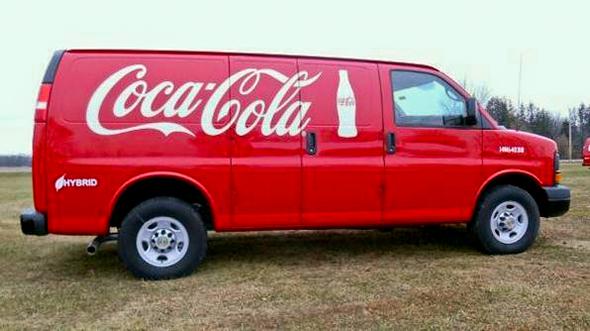Hybrid cars account for only a tiny sliver of sales in the U.S.—about 3 percent of April’s total—and understandably so. These consumer show horses cost significantly more than regular sedans and coupes, which often get decent gas mileage on their own. The typical driver simply doesn’t cover enough miles to recoup the higher costs through lower gasoline purchases. And that’s even with the generous government tax credits and subsidies.
But it’s a much different calculus for industrial workhorses. Imagine you could somehow take a regular cargo van that guzzles gas and will be driven for 200,000 miles over its long lifetime—and then install equipment (a battery pack, an electric motor) that makes it run like a hybrid. If you could offer it at a reasonable upfront price, economically rational fleet managers would take a look, even if there was no subsidy or tax credit.
That’s precisely what XL Hybrids, a startup in Brighton, Massachusetts, has done during the last several years. Some car owners pimp their rides by adding spoilers, rims, or sound systems. XL Hybrids asks its calculating customers to pimp theirs by adding inconspicuous fuel-saving systems that cost about $8,000. Coca-Cola has already bought 100.
XL Hybrids was started in 2008 by clean-tech veterans who wanted to avoid having their businesses rise and fall with subsidies and tax credits, which have a way of coming and going. They thought a hybrid power train pitched at people who own gas-guzzling vehicles that rack up a lot of city driving miles might be a winning proposition, especially if they could show that the $8,000 investment would pay for itself in three years or less. Their targets: the delivery and utility fleets that rely on General Motors light-duty vans.
XL Hybrids doesn’t make vans, and the van manufacturers don’t make XL Hybrids. After a conventional van leaves the factory, an outfitter installs the system: an electric motor, a lithium ion battery pack, an inverter, and so on. As with factory-produced hybrids, the brakes help regenerate the battery, and the battery helps drive the vehicle. The company says the system improves gas mileage by 25 percent for vehicles like the GM 2500 van, from 12 miles per gallon in city driving to 15 miles. That cuts fuel costs by 20 percent. An “upfitted” van that drives about 20,000 miles annually will save about $1,600 per year on gas costs alone (based on a $4 per gallon price). Customers who drive about 25,000 miles per year can recoup their costs in anywhere from 30 months to four years.
“Most of our customers are putting at least 250,000 miles on these vehicles,” said Tod Hynes, chief executive officer of XL Hybrids.
In 2012, XL Hybrids persuaded Coca-Cola, which has one of the biggest private-sector fleets in the U.S., to test out two upfitted GM vans. Coca-Cola had already bought hundreds of diesel-electric hybrid cabs for its heavy delivery trucks—the semis seen lumbering down the highway. But those purchases were often supported by subsidies or grants. The company was looking for options to help improve the efficiency of its fleet of 3,500 vans used by service technicians, the people who drive around and repair coolers, fountain dispensers, and the like.
The actual mileage improvement of the upfitted GM vans was slightly less than advertised. “We saw anywhere from a 15 percent to 20 percent mileage improvement,” said Bruce Karas, vice president of environment and sustainability for Coca-Cola North America. And that was significant, even if there were no tax credits available. “The initial assessment is that over the life of a typical vehicle—about 10 years and 200,000 miles—the investment would pay for itself three times over,” said Karas.
Savings come in other forms. Since the system adds more torque, van purchasers can buy vehicles with smaller (and hence cheaper) engines and still get the same performance. That can save about $1,000 upfront. The system reduces stress on the brakes, which cuts maintenance costs. And having to stop for gas less frequently translates into higher productivity. “You can imagine over the life of the vehicle, that can save you a couple weeks of labor,” XL Hybrids’ Hynes said.
Compared with other transport innovations, XL Hybrids had another factor in its favor: Kitting out a regular van to run as a hybrid is much less disruptive than adding all-electric vans or vehicles that run on natural gas. “The key thing with transportation is you have to look at what modifications you have to make as to how you deploy your fleet and manage them,” Coca-Cola’s Karas said. Using hybrids doesn’t force companies to install charging stations and natural gas filling equipment, and it doesn’t range anxiety in drivers. After the pilot, Coca-Cola bought another 100 at the end of 2013.
XL Hybrids runs lean. It sources components from parts makers like Johnson Controls and has deals with the aftermarket companies—the “upfitters”—Knapheide and Leggett & Platt. With 21 employees, XL Hybrids has raised about $10 million in funding. It sold hundreds of systems in 2013 and plans to sell in the thousands in the current year; other customers include Federal Express and Canadian Linen.
The company’s story highlights an important theme. Energy-related innovations aimed at consumers tend to suck up most of the heat and light, e.g., Tesla and the Nest thermostat. But the most important action often takes place in corporate purchasing departments. Innovations that don’t make economic sense for individuals can frequently make a great deal of sense for corporations.
Rather than target customers who are willing to pay a premium to show off their environmental cred, XL Hybrids pursues those who have the most to gain financially from incremental improvements. As Hynes put it: “We’ve targeted the customers who drive the most miles.”
